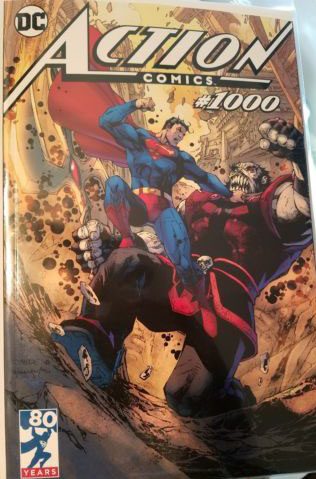80 years, over 1000 issues – The History of Superman

The Jim Lee Variant for Action Comics #1000.
On June 2, 1932, a sixty-year-old Jewish immigrant named Mitchell Siegel died of a heart attack during a robbery of his second-hand clothing store in Cleveland, Ohio, leaving his seventeen-year-old son Jerry distraught. With his best friend Joe Shuster at his side and in the wake of tragedy, Jerry would create one of the most enduring American icons of all time— Superman.
Although the character would not appear fully until Action Comics #1 in 1938, a full six years later, eighty years earlier and 999 issues ago, the name Superman was first used in a short story written by Siegel and Shuster, titled ‘The Reign of the Super-Man’, in 1933’s ‘Science Fiction: The Advance Guard of Future Civilization #3’.
The comic told the tale of a man named Bill Dunn, who gained extraordinary psychic powers and became set on world domination. Bearing no resemblance to the character we know today, he was eventually reworked to be a hero, after Siegel read the proto-comic book ‘Detective Dan: Secret Operative No. 48’. With Shuster, Siegel created the comic ‘The Super-Man,’ and pitched it to the company that published Detective Dan.
While the two received an encouraging letter, the company chose not to run the story. This proved to be too much for Shuster, who chucked the pages of artwork and letters into a fire. Only the cover was saved by Siegel, who still saw potential in the character. While the two worked on the comic, they also wrote for the magazine known as Detective Comics, and eventually pitched it to the publisher, National Comics. They were unsuccessful, as the comic was rejected again.
This year, Superman has reached eighty years in age, and 1000 ‘Action Comics’ issues to his name.
Luckily, National was looking to jumpstart their new ‘Action Comics’ anthology, and decided to use the rejected Superman comic strips as one story for the issue, along with other strips like ‘Chuck Dawson’ and ‘Zatara Master Magician’. Shuster and Siegel sold the rights to Superman for $130, or $2,301.05 in today’s money. Action Comics #1 hit the stands in June of 1938, as an immediate success, selling a whopping 130,000 comics.
Over the next few years, Superman became a cultural icon. In 1940, ‘The Adventures of Superman’ radio series premiered, catapulting the character into the spotlight even further, as well as adding aspects of the character’s story such as Jimmy Olsen, Perry White, and the infamous crystal Kryptonite. Superman’s can-do attitude and strong moral compass struck a chord with activists. When activist Stetson Kennedy infiltrated the KKK and leaked information to the writers at the radio show, they promptly wrote an episode on Superman battling the Klan, which dealt a massive blow to the KKK’s reputation and public image.
Then, in 1941, the Fleischer Studios company debuted several cartoons on the character, which can now be found on Youtube. Soon after, Superman made his big screen debut in films such as ‘Superman and the Mole Men,’ as well as several serials.
Unfortunately for Siegel and Shuster, they were not seeing a penny out of these profits, due to copyright. While they sued DC Comics in 1947, they only managed to gain the rights to Superboy, who was declared a separate entity. They sued again in the 60’s, but failed. But then, in 1975, supporters and fellow comic book creators Neil Adams and Jerry Robinson helped raise awareness of the issue after ‘Superman: The Movie’ was announced in 1975. Siegel and Shuster finally made a deal with National, now renamed DC Comics, in that they would get an annual stipend of $20,000, an amount which eventually increased, and their names credited as creators on every form of media containing the character.
The film ‘Superman: The Movie’ was released in December of 1978, with the tagline “You’ll Believe a Man Can Fly.” Directed by Richard Donner and starring Christopher Reeves and Gene Hackman, the film holds a 93% rating on Rotten Tomatoes, and boasts a special achievement Academy Award along with three other nominations. The sequel, ‘Superman II’, has an 87% rating however, the next two films in the franchise, ‘Superman III’ and ‘Superman IV: The Quest for Peace,’ hold 26% and 12%, respectively. ‘Superman’ and ‘Superman II’ remain favorites among fans, due to their quotable lines and popular influences.
In 1985, the world(s) of DC Comics came under threat in the twelve-part maxi-series ‘Crisis on Infinite Earths,’ which saw the death of longtime Superman supporting character Supergirl, as well several others in the DCU. In the wake of the event, DC launched both a six-part miniseries titled ‘Man of Steel,’ retelling Superman’s origin story for a new generation. DC also released a two-part story titled ‘Whatever Happened to the Man of Tomorrow?’ which told the final days of the iconic character from the perspective of Lois Lane. The stories were written by John Byrne and Alan Moore respectively, and are hailed as modern classics in the comic book medium. Byrne also began to write the ongoing adventures of Superman, until his departure in the early 90’s.
With his leaving, a plan was concocted to create one of the most infamous Superman stories ever. Sadly, Joe Shuster did not live to see the story, passing away in 1992, before its publication. But in the same year the world would bear witness to another death, that of Superman himself.
‘The Death and Return of Superman’ was a 1992-1993 event telling the tale of the death and miraculous resurrection of Superman, meeting his demise in a mutual killing by the hands of the creature known as Doomsday. The final fight was shown in the pages of Superman Vol. 2 #75, whose final lines still stick with fans: “For this is the day that a Superman died.” The act of killing off such a popular American icon was so influential, that even late night talk show host Jay Leno wore a superman armband during one of his shows. The character was revived as a part of the ongoing story arc less than a year later in the pages of Man of Steel #25, responding to the threat of destroying his home city with the words: “Metropolis? Over my dead body!”
After the event was over, wedding bells began to ring. Clark Kent/Superman’s longtime love interest Lois Lane finally learned of his secret identity, and in 1996, the two were happily married in ‘Superman: The Wedding Album’. Happy times continued in the Superman mythos, however Jerry Siegel was not around to see it. He passed away in January of the same year. With his two beloved creations were married, Jerry Siegel had lived to see the idea of a bulletproof man spring out from a tragedy and into the hearts of those across the world.
Soon after, a new slew of influential Superman comics took to the stands. In 2001, ‘What’s So Funny About Truth, Justice, and the American Way’ asked whether Superman should resort to murder. In 2003, ‘Superman: Red Son’ asked what would happen if Superman had landed in Soviet Russia instead of Kansas. In 2004, ‘For Tomorrow’ asked whether Superman could really save everyone. In 2005, ‘All-Star Superman’ told the story of the Man of Steel being given a year to live, and the consequences it would have to the world at large. In 2006, ‘Superman: Last Son’ told the tale of Superman and Lois raising a kryptonian child with a deadly secret. And in 2008, ‘Superman: Brainiac’ reinvented a classic villain for a new age.
Then, in 2011, the DC Universe went through a flashpoint and rebooted, launching all of their comics back to issue one. In the new Action Comics, Grant Morrison went back to the early days of superman for eighteen issues, and the renumbering would last until 2018’s DC Rebirth initiative, where Lois and Clark would finally have a son, named Jon Kent, who inherited his father’s powers and the name Superboy.
Superman is currently set to be a cornerstone in the new ‘Doomsday Clock’ series, which is a sequel to the critically acclaimed ‘Watchmen’ 1986 series, where Superman prepares to meet the powerful Doctor Manhattan for the fate of the universe in a mental battle of hope vs. despair.
This year, Superman has reached eighty years in age, and 1000 ‘Action Comics’ issues to his name. In celebration of the anniversary, Acclaimed writer Brian Michael Bendis has jumped ship from Marvel Comics in order to write his ongoing adventures, starting in issue 1000 and continuing into the new volume of the ‘Man of Steel’ miniseries.
It may be the story of a man of tomorrow from another galaxy, but Superman is possible the most American story to date.
Gearod Murphy is a junior who is on his first year at the school newspaper, as a Staff Reporter for ‘The Science Survey’ and a People section writer...










